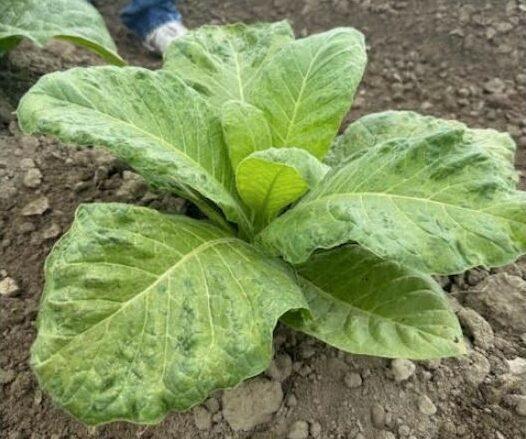Managing Tobacco Mosaic Virus (TMV) in Tobacco
go.ncsu.edu/readext?1074153
en Español / em Português
El inglés es el idioma de control de esta página. En la medida en que haya algún conflicto entre la traducción al inglés y la traducción, el inglés prevalece.
Al hacer clic en el enlace de traducción se activa un servicio de traducción gratuito para convertir la página al español. Al igual que con cualquier traducción por Internet, la conversión no es sensible al contexto y puede que no traduzca el texto en su significado original. NC State Extension no garantiza la exactitud del texto traducido. Por favor, tenga en cuenta que algunas aplicaciones y/o servicios pueden no funcionar como se espera cuando se traducen.
Português
Inglês é o idioma de controle desta página. Na medida que haja algum conflito entre o texto original em Inglês e a tradução, o Inglês prevalece.
Ao clicar no link de tradução, um serviço gratuito de tradução será ativado para converter a página para o Português. Como em qualquer tradução pela internet, a conversão não é sensivel ao contexto e pode não ocorrer a tradução para o significado orginal. O serviço de Extensão da Carolina do Norte (NC State Extension) não garante a exatidão do texto traduzido. Por favor, observe que algumas funções ou serviços podem não funcionar como esperado após a tradução.
English
English is the controlling language of this page. To the extent there is any conflict between the English text and the translation, English controls.
Clicking on the translation link activates a free translation service to convert the page to Spanish. As with any Internet translation, the conversion is not context-sensitive and may not translate the text to its original meaning. NC State Extension does not guarantee the accuracy of the translated text. Please note that some applications and/or services may not function as expected when translated.
Collapse ▲Tobacco Mosaic Virus (TMV) is one of the most persistent and easily spread viruses in tobacco. Here’s what you need to know and how to manage it effectively.
What is Tobacco Mosaic Virus (TMV)?
Tobacco Mosaic Virus (TMV) is a highly stable and infectious plant virus that affects a wide range of host plants, particularly in the Solanaceae family, including tobacco, tomato, pepper, and petunia.
It was the first virus ever discovered and is notable for its ability to survive on surfaces for extended periods. TMV is easily spread by human handling, contaminated tools, and even cigarettes.
Symptoms in Tobacco
In tobacco, TMV symptoms typically include:
- Mosaic patterning of light and dark green on the leaves
- Leaf distortion, such as puckering or blistering
- Stunted growth and reduced vigor in severe cases
Although TMV doesn’t kill the plant, it can significantly reduce yield and quality.

TMV-infected tobacco plant. Photo by Brittany Pendleton, N.C. Cooperative Extension.
How TMV Spreads
- Contact with infected plants
- Contaminated tools, equipment, hands, and clothing
- Soil or growing media
- Cigarettes and other tobacco products
TMV can hitch a ride from a cigarette to your hands—and from there, to everything you touch.
Managing TMV: Preventing Spread
- Milk proteins inactivate TMV. All types of milk (full, skim, powdered) mixed with clean water are effective.
- Spray plants with a 20% milk solution 24 hours before handling. Let plants dry before touching.
- Disinfect tools, hands, and benches by spraying with milk solution for at least 1 minute or dipping for 10 minutes.
- Milk won’t cure infected plants but protects healthy ones for up to 10 days. Reapply after rain, irrigation, or new growth.
- Remove infected plants using gloves.
- Dip hands and gloves in milk solution or phosphate detergent (dish/laundry soap) before and after work.
- Work in healthy areas first, then move to infected areas last.
- Wash clothes with detergent and spray shoes with 20% milk solution or 10% bleach after working in infected areas.
Best Sanitation Practices for Equipment
- Move equipment to a designated area where runoff won’t enter fields
- Clean all equipment using a pressure washer with soapy water (1–2% detergent solution) to remove soil and debris
- Disinfest using a 10% bleach solution (5.25% sodium hypochlorite), 2% Virkon®S, or a 20% nonfat dry milk solution with or without 0.1% Tween 20 (surfactant), ensuring all surfaces remain wet for at least 1 minute
- Rinse equipment with water to avoid corrosion or mold
- Allow equipment to dry completely or for at least 5–10 minutes before moving
Seed Treatment
Milk treatment is not effective for seeds. Instead:
- Soak seeds for at least 15 minutes in either:
- 3% trisodium phosphate (Na₃PO₄)
- 9% Calcium hypochlorite (Ca(ClO)₂)
These treatments help inactivate the virus without inhibiting germination.
Greenhouse Risk and Tray Disposal
Plants infected with TMV in the greenhouse show symptoms similar to those in the field: mosaic leaf patterns, distortion, and stunted growth. These symptoms often become more visible as plants mature and may be mistaken for nutrient or environmental issues.
Trays that held TMV-infected plants should be discarded. TMV is extremely durable and can survive steaming. Even bleach may not be fully effective due to the hydrophobic nature of styrofoam, which prevents thorough surface penetration.
Residual bleach can also cause phytotoxicity—leading to poor germination, root damage, or weakened transplants. Best practice: Do not reuse trays that previously held infected plants.
For more information, see Tobacco Greenhouse Practices.
Resistant Varieties
The following varieties have been designated as resistant to TMV based on historical data:
- CC 27
- CC 37
- CC 67
- CC 143
- GF 318
- GL 26H
- GL 976
- NC 297
- PVH 1610
- PVH 2254
- PVH 2275
- PVH 2310
- PVH 2343
- PVH 2408


